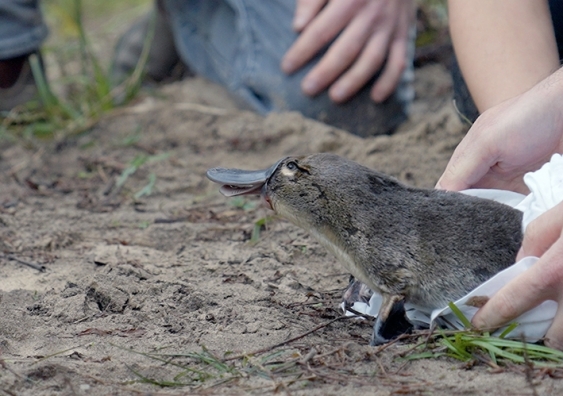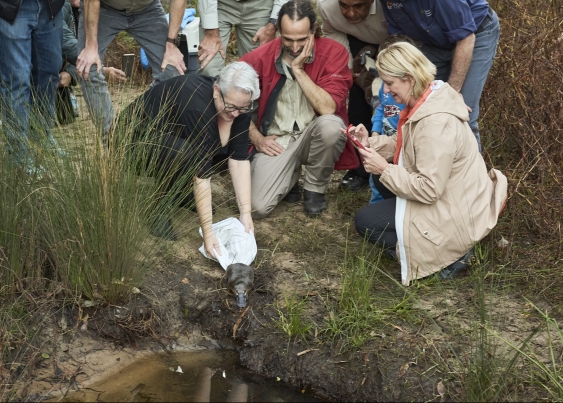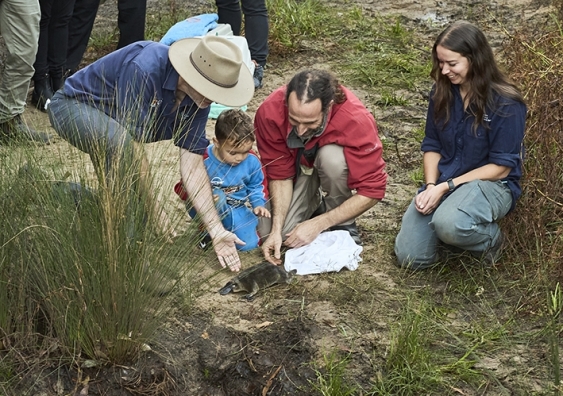Long journey home: the return of the platypus to the Royal National Park
For the first time in half a century, the Royal National Park will have a population of platypus.
For the first time in half a century, the Royal National Park will have a population of platypus.

Lachlan Gilbert
UNSW News & Content
(02) 9065 5241
lachlan.gilbert@unsw.edu.au
Scientists from UNSW Sydney have re-introduced platypuses to Royal National Park after an absence of more than 50 years since any confirmed sighting of these iconic native animals.
Leading a team with the Taronga Conservation Society Australia, NSW National Parks and Wildlife Service (NPWS) and WWF-Australia, the researchers from UNSW’s Centre for Ecosystem Science released a small group of four female platypuses on the banks of the Hacking River to watch them quickly waddle forward into the water of their new protected home.
First proposed by UNSW ecologists three years ago, the plan will see a total of six female and four male platypuses released at the same location, bringing the founding population in the Royal National Park (RNP) to a total of 10.
Penny Sharpe, Minister for the Environment, said the reintroduction of platypus to Royal National Park would re-establish a self-sustaining and genetically-diverse platypus population.
“The iconic platypus is under immense pressure. The work that has gone into this project to get to the point of releasing these platypuses is essential to assure the security of these species into the future,” Ms Sharpe said.
“Royal National Park is Australia’s oldest national park and I am pleased this historic reintroduction will help re-establish a sanctuary for this iconic species.
“Translocation is just one conservation measure that can help ensure the survival of NSW species such as platypus against climate change.”
Read more: Platypuses likely gone from Royal National Park, but they may come back
The platypuses were collected with licensing approved by the NSW Department of Planning and Environment from southern NSW in locations that support thriving populations of platypuses.
The iconic platypus, known for its unique mammalian features including their duck-like bill, venomous spur in the male and egg-laying ability, is one of five species of monotremes only found in Australia.

NSW Environment Minister Penny Sharpe releases a platypus on the banks of the Hacking river. Photo: Richard Freeman/UNSW Sydney
Lead researcher Dr Gilad Bino has more than two decades of experience in ecological research and implementing conservation programs. With his colleagues, he established the Platypus Conservation Initiative more than eight years ago and has been studying platypus populations across their range. He is excited to see years of planning come to fruition for the return of one of Australia’s favourite animals to a habitat just an hour away from Sydney’s CBD.
“This is a landmark project that will not only restore the platypus to its rightful place in Royal National Park but also aims to set the framework for future conservation efforts of a species largely overlooked,” Dr Bino says.
“An integral part of future conservation efforts will be our preparedness to undertake emergency responses to rescue and translocate platypuses from drought-affected areas,” he says.
Dr Tahneal Hawke, a researcher on the project, has contributed invaluable research in preparation for the reintroduction by assessing platypus population sizes and demographics at the sourcing sites.
“The welfare of the platypuses was always our highest priority – both at the source sites and the release site at Royal National Park,” she says.
“We collected platypuses from multiple sites across multiple rivers to ensure no impacts to the source populations, and to ensure genetic diversity of the introduced population at Royal National Park.”

The UNSW team releases a platypus on the banks of the Hacking river. Photo: Richard Freeman/UNSW Sydney
Professor Richard Kingsford, Director of the Centre for Ecosystem Science and is also a member of the UNSW platypus research team, says platypuses are currently facing multiple threats across their range.
“We will learn a lot by this reintroduction,” he says.
“We are already working with NPWS who are controlling fox populations. We really want platypus to be the new sentinels of our rivers. If your platypuses are doing well, the river is probably in pretty good shape. Royal National Park is such a great place to start as the second oldest national park in the world. It is fitting that we should be returning this top river predator to its right place. Exciting reintroductions like this provide a focus for monitoring management and learning how to deliver for conservation.”
Read more: More rescue missions possible as platypuses rehomed
In fact, the Platypus Conservation Initiative has already undertaken a platypus translocation of sorts when they rescued platypus from drying pools severely affected by the 2019 droughts from Tidbinbilla Nature Reserve and transferred them to safety at Taronga Zoo. Taronga has also played a pivotal role in the current translocation project by temporarily housing the platypuses collected from southern NSW in purpose-built facilities where they received health checks, were assessed for release and fitted with transmitters.
Prior to introducing the platypuses to their new home in Royal National Park, the UNSW researchers spent months evaluating the water quality and food availability along the Hacking River, says Prof. Kingsford.
There were also concerns that flooding in 2021 had led to overflow of coal material, but after carefully testing water quality, the team found no evidence that poor water quality had affected the system.
“We have been careful to keep monitoring water quality and platypus food availability through the extreme floods of last year, the pollution event and now after the flooding this year,” says Prof. Kingsford.
“It is really encouraging to see that there are animals for platypuses to eat and depend on doing so well, and the good water quality.”
The macroinvertebrates that platypus feed on – including a range of different small aquatic animals such as dragon fly nymphs, caddis fly larvae and small shrimps – have been found in healthy numbers along the Hacking River over the past year, with the most recent survey completed last month.
Dr Hawke says that The Platypus Conservation Initiative will be monitoring the platypuses’ survival and movements in the park in the months and years to come to gain valuable insights about their establishment in this new environment.